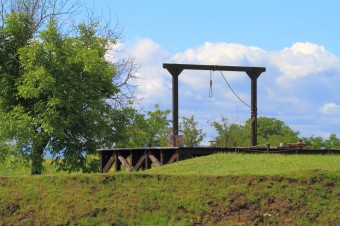This Day in History: February 3rd
Today in History: February 3, 1780
 Just as the clock was striking midnight in Litchfield County, Connecticut on February 3, 1780, a young man brutally bludgeoned to death his landlord Caleb Mallory, Caleb’s wife Jane and their nine-year-old granddaughter. After the murderer robbed the home, he burned it down with two of the couple’s other sleeping grandchildren still inside, two boys- aged six and four.
Just as the clock was striking midnight in Litchfield County, Connecticut on February 3, 1780, a young man brutally bludgeoned to death his landlord Caleb Mallory, Caleb’s wife Jane and their nine-year-old granddaughter. After the murderer robbed the home, he burned it down with two of the couple’s other sleeping grandchildren still inside, two boys- aged six and four.
His name was Barnett Davenport, a 19-year-old soldier – and deserter – of the Continental Army, and often cited as America’s first mass-murderer (though we think the Native Americans, particularly, might argue with that one).
Michael-John Cavallaro, an author and history detective from New Milford, CT, had been tirelessly researching this gruesome and tragic tale when he discovered a 14-page confession by Davenport at the University of Virginia in the summer of 2010. In it, Davenport exhibits classic signs we associate with a sociopath: an obsession with committing murder from a young age, habitual robbery and pathological lying.
Davenport also made yet another slimeball move, this one implicating his kid brother in the murder.
Barnett managed to remain hidden for six days before he was apprehended, and during that time his younger brother Nicholas was arrested. Turned out his big bro had “borrowed” his identity to get hired at the Mallory’s farm, which also made it quite easy to frame Nicholas for the murders. Cavallaro reports that according to the scant contemporary evidence available, most believed Nicholas was involved in the crime or least tried to cover for his brother, which must have made for awkward Sunday dinners.
In any case, Barnett’s recently re-discovered confession finally puts that theory to rest.
Barnett Davenport was found guilty of murder and arson. He was sentenced to 40 lashes and to hang at Gallow’s Lane at Litchfield, CT on May 8, 1780. His brother Nicholas was sentenced to 40 lashes and life imprisonment at Newgate Prison. He was also forced to stand and watch his brother die on the gallows. Nicholas went to prison, but escaped. He was duly returned, but was released two years later.
If you liked this article, you might also enjoy our new popular podcast, The BrainFood Show (iTunes, Spotify, Google Play Music, Feed), as well as:
- The First Convicted Murderer in America
- The Tragic Family Life of Kelsey Grammer
- Woody Harrelson’s Father Was a Contract Killer
- One of the Last Instances of a “Testimony of a Ghost” Being Given Credence to in a U.S. Court Trial Takes Place in the Murder of Elva Zona Heaster
| Share the Knowledge! |
|





Quoting from the article: “His name was Barnett Davenport … often cited as America’s first mass-murderer (though we think the Native Americans, particularly, might argue with that one).”
I agree with the comment concerning how the “Native Americans … might argue,” but not in the “politically correct” way that the writer intended!
Instead, any honest American Indian today would admit that “America’s first mass-murderers” were not Barnett Davenport (and his ilk), but rather the many murderous members of their own ethnic group — during many centuries before Barnett Davenport was even born. This would include (1) American Indian mass-murderers who killed fellow Indians and (2) American Indian mass-murderers who killed innocent Europeans that were visiting, or trying to settle in, America.
You may have noticed that I used the term, “American Indian,” in lieu of the relatively recently coined (and bogus, “politically correct”) term, “Native American.” I do this for two reasons: (1) because the majority of American Indians use the good ol’ term (American Indian), and (2) because, even though my four grandparents were born in central Europe, I myself am a “native American.” Yes, by the mere fact that I was born in (am native to) America, I am a native American.
No one should forget that the Western Hemisphere was once uninhabited by any human beings — and that even the American Indians are descendants of immigrants (believed to have crossed from Siberia into Alaska before migrating, over millennia, to the south). Thus, they have no more, and no less, claim to the label, “native American,” than I do!